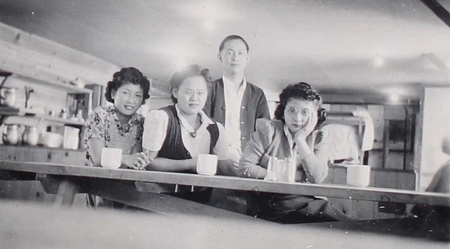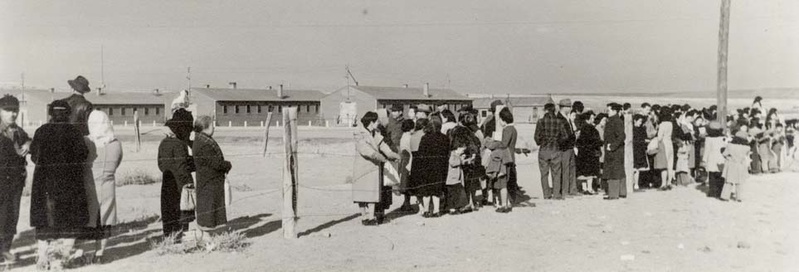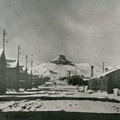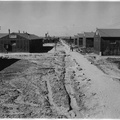6. Resentment and Resistance to the Fence
Like pretty much all of the other camps, Heart Mountain was still being built as the inmates were arriving. Among other things, there were no fences at the camp when inmates arrived in August 1942. But even though there were no attempted escapes or other similar incidents, construction by army contractors of a barbed wire fence around the perimeter of the camp began in October, much to the dismay of the inmates.
Already disturbed by the climate, the unfinished state of the camp and the general chaos the first few months, the fence was a disheartening reminder of their situation. “There was really no need for a fence. You could walk 20 miles through the sagebrush and not run into anything,” recalled Bill Hosokawa in a 2001 interview. When the fence started to go up “there was a great deal of resentment in the camp. And I think the resentment was unanimous.” Heart Mountain Project Attorney Jerry W. Housel wrote in mid-November that at “practically every meeting or discussion group since the project started the subject comes up with a rather bitter tone.”1
The contractor initially used inmate laborers to help build the fence, but eventually those workers refused to continue. Though Housel and other WRA administrators opposed the fence, the army pushed through the completed fence. Later in November, a petition calling for the removal of the fence and guard towers was signed by 3,000 Heart Mountain inmates—nearly half of all adults in the camp—and forwarded to WRA Director Dillon Myer. The petition stated that the “fence and towers are ridiculous in every respect, an insult to any free human being, a barrier to a full understanding between the administration and the residents.” The fence nonetheless remained. Writing in the summer of 1943, WRA Community Analysis Section Head John Embree wrote that the fence was “still an acute thorn in the side of evacuees and will remain so until it is removed.”
Though the fences were never removed, enforcement of boundaries faded over time, with the staffing of guard towers reduced, then withdrawn entirely by August 1944. Inmates reported being able to easily squeeze through gaps in the barbed wire to hike or pursue other outdoor activities with the tacit approval of the administration in the second half of Heart Mountain’s life.2
Protests around the building of fences also took place at Gila River, Minidoka, and Topaz.
7. Artists, Activists, and Other Notables
This is also subjective, but it seems that there were many well-known Japanese Americans incarcerated at Heart Mountain relative to other camps. One indicator is the number of people who have articles in the Densho Encyclopedia. By that measure—and adjusting for camp populations—Heart Mountain has more than any other camp except for Topaz. While the Topaz notables include many artists, a group that is probably overrepresented in the encyclopedia, the Heart Mountain group is a diverse one.
It includes such Issei leaders as gardening chronicler and organizer Shoji Nagumo, Okinawan activists Shingi Nakamura and Paul S. Kochi, painter Hideo Date, and others. There were resistance leaders such as Frank Emi and other leaders of the Fair Play Committee, along with such establishment figures as Bill Hosokawa. Mary Oyama Mittwer, Louise Suski, and Albert Saijo were among the many Nisei literary figures at Heart Mountain. There seemed to also be an unusual number of Nisei there who became well-known in their fields outside of the Japanese American community, including photographer Hikaru Iwasaki, graphic designer S. Neil Fujita, cartoonists Willie Ito and Robert Kuwahara, as well as Norman Mineta. There were also the unique and evocative stories of Stanley Hayami, whose diary and letters from his time in Heart Mountain have inspired a book and documentary film, and Estelle Ishigo, a white woman who chose to be incarcerated alongside her Nisei husband and chronicled their lives in the camp.
8. Food Shortages
“There has been trouble with food here—shortage due to bad play.”
—Letter from Sophie Tagami Toriumi to Olive Hutchison, Sept. 15, 1942.3
Food shortages also greeted Heart Mountain inmates in the early weeks of the camp. These resulted from a combination of underordering of food, truck shortages that led to distribution problems, and lax regulations that allowed inmates to eat at any mess hall and at times at multiple mess halls. This led to a chaotic situation that saw some mess halls having too much food and some too little, food arriving too late to be prepared on time, and inevitably, some inmates going hungry.

With the project steward inaccessible to the camp population, inmate assistant stewards drew the brunt of criticism. The situation came to a head on September 6, in the midst of arrivals to the camp, when a cook in Block 2 tried to attack an inmate assistant steward with a butcher knife out of frustration. It was revealed that the cook had been working twelve-hour-plus days and had been unable to reach his bosses. As disfunction continued, a September 13 meeting of cooks and the project steward led to threats of violence.
Eventually, Heart Mountain Director Christopher E. Rachford appointed a committee of nine male teachers to investigate. Their report largely blamed the staff, resulting in the eventual replacement of Chief Steward Ernest Hawes, along with the institution of policies that improved the distribution of food and that dictated that inmates eat in assigned mess halls. Even though the food supply problems largely ended, the lingering fear of food shortages remained, leading to “[c]onsiderable hoarding of food in mess halls and apartments,” according to the Mess Management Section Final Report.4
9. Even More Protests
Beyond the fence and food issues—and the well-known story of draft resistance—there were several other instances of inmate unrest at Heart Mountain, many of which took the form of labor disputes. Ultimately, none exploded into the large scale revolts that took place at Manzanar and Poston.
According to the Internal Security Section Final Report, internal security head R. O. Griffin objected to the inmate officers’ “liberal, social, non-severe form of conducting police work.” As Ed Marks of the WRA main office put it, Griffin’s “lack of tact” led to the resignation of inmate police chief “Rosie” Matsui on October 26, 1942, followed by the rest of the police force. With no police force on duty, the Temporary Community Council stepped in and was able to convince many members of the force to return to duty on a voluntary basis under their direction, which they did for much of November. Inmate friendly Project Director Charles Rachford held a “trial” of Griffin that ultimately led to Griffin’s resignation on December 1. The inmate police force returned to work and continued to keep the peace at Heart Mountain without a white supervisor until the end of May 1943.5
In the spring of 1943, after the chaos of registration, inmate workers in the Motor Pool Section (MPS) staged a five-day walkout following a fight between an inmate tractor foreman named Henry Kiyomura and the assistant chief of the MPS, Elbern Linderman on April 27, 1943. The roots of the fight stemmed from the alleged failure of the MPS to provide the necessary tractors to agricultural workers; Kiyomura and Linderman had also exchanged angry words three days prior. While the two men fought, three other white staffers, including Everett Lane, the head of the Transportation Supply Division, watched, stopping the fight only when Kiyomura seemed to be getting the upper hand. Word of the fight spread, and inmate MPS workers walked off their jobs. The walkout also effectively halted repair work on the canal and much of the agricultural work, since those workers now had no way to get to their jobs.
Two days later, the workers issued a series of demands including the firing or reassignment of Lane. After five days, the workers agreed to return to their jobs pending an investigation by an outside committee. In the aftermath of the walkout, agricultural workers staged a slowdown in May with inmate workers refusing to work the 4 am shift, forcing white WRA staffers to take those shifts.6
There were also two labor disputes in the hospital. In the first instance, newly hired Chief Nurse Margaret Graham incurred the ire of inmate doctors when she moved desks from the doctors’ quarters (under orders from Chief Medical Officer Charles E. Irwin) on February 11, 1943, moving their things from the desks to the floor. The doctors circulated a petition calling for her removal, and inmate medical staff walked off the job, closing the hospital. Camp Director Guy Robertson largely took the inmates’ side, leading to Graham’s resignation and a quick resolution to the walkout.
Graham’s successor, Anna S. Van Kirk also clashed with the inmate staff in trying to enforce greater order and discipline, leading to 102 hospital workers walking off the job on June 24, 1943. In this case, doctors and nurses were not among those striking, and the strike leaders did not have the full support of the inmates. In the end, the administration fired the strikers, while sending three of the strike leaders to the WRA prison in Leupp, Arizona. It ultimately rehired many of the strikers.7
10. Heart Mountain Community Activities
Recreational programs at Heart Mountain were run by an inmate controlled trust organization, Heart Mountain Community Activities (HMCA), which was established in April 1943. It was the only such arrangement in any of the WRA camps. Run by a seven-member board of trustees, HMCA officially took over community activities on April 20, 1943. It initially ran out of an office in the administration section, but later moved to three refashioned CCC buildings in the high school block. The HMCA took over a program that had been directed by Marlin T. Kurtz, the community activities supervisor since the camp’s opening. In addition to overseeing the range of recreational activities, the HMCA oversaw the building of various recreational facilities and coordinated the use of the block recreation halls, which were used for many purposes, including churches, nursery schools, and even emergency housing. Over the course of its life, HMCA more or less broke even, with about $70,000 in income and expenditures. Movie screenings generated about $15,000 in profit, which along with over $11,000 in donations, funded the other programs. The recreational activities themselves were similar to those at other camps: sports leagues; shows, dances, and movies; and perhaps the most extensive youth club program of any WRA camp.8
References
1. Nelson, Heart Mountain, 83–85; Bill Hosokawa Interview by Alice Ito (primary), Daryl Maeda (secondary), Segment 18, Seattle, Washington, July 13, 2001, Densho Visual History Collection, Densho Digital Archive; Jerry W. Housel, Project attorney report, Nov. 17, 1943, p. 5, JAERR BANC MSS 67/14 c, folder M1.35:1.
2. [Community Analysis Section], “Center Living Conditions,” JAERR BANC MSS 67/14 c, folder M1.00;Heart Mountain Sentinel, Nov 21, 1943, 1, 6; John Embree, “Notes on Heart Mountain, July 31 to August 4, 1943,” pp. 7–8 Community Analysis Reports and Community Analysis Trend Reports of the War Relocation Authority, 1942-1946, Reel 3, Washington, [D.C.]: National Archives, National Archives and Records Service, General Services Administration, 1984; [Hansen], “The Heart Mountain Community,” 8–9; Hal Keimi Interview by Brian Niiya (primary), Emily Anderson (secondary), Segment 12, Los Angeles, California, February 5, 2019, Densho Visual History Collection, Densho Digital Repository; Okuno Interview, Segments 17 and 21. Eric L. Muller’s Lawyer, Jailer, Ally, Foe: Complicity and Conscience in America’s World War II Concentration Camps (University of North Carolina Press) also includes a discussion of the fence controversy through Housel’s eyes.
3. Letter from Sophie Tagami Toriumi to Olive Hutchison, Sept. 15, 1942, Occidental College Library, Online Archive of California.
4. Frank Cross, “Social Disorganization: Center Living Conditions: Mess Halls,” Sept. 21, 1942, JAERR BANC MSS 67/14 c, folder M1.00; Frank Cross, “Social Disorganization: Center Living Conditions: Housing,” JAERR BANC MSS 67/14 c, folder M1.00; Ike Hatchimonji Interview by Martha Nakagawa, Segment 11, Los Angeles, California, November 30, 2011, Densho Visual History Collection, Densho Digital Archive; Fred J. Haller, Final Report, [Heart Mountain] Mess Management Section, p. 2, JAERR BANC MSS 67/14 c, folder M1.05:3.
5.Stanley Adams, “Internal Security Section Final Report,” pp. 2–3, 6–8, JAERR BANC MSS 67/14 c, folder M1.05:9; Ed Marks, “Notes on Nov. 1–4, 1942 Visit,” p. 2, JAERR, BANC MSS 67/14 c, folder M2.33; [Community Analysis Section], “Heart Mountain Community: I. Moving In,” 3, 5; Cates, “Comparative Administration,” 195–97.
6. Jerry W. Housel, Project attorney reports, Apr. 22 to 29, Apr. 29 to May 6, and May 13 to 27, 1943, JAERR BANC MSS 67/14 c, folder M1.35:3; John I. Reichert, “Motor Transportation and Maintenance Final Report,” pp. 2–3 JAERR BANC MSS 67/14 c, folder M1.05:7; Glenn T. Hartman, “Agriculture Section Final Report,” pp. 15–16, JAERR BANC MSS 67/14 c, folder M1.05:7; [Community Analysis Section], “Heart Mountain Community: II. Being Sorted,” 5–8.
7. Louis Fiset, “The Heart Mountain Hospital Strike of June 24, 1943,” in Remembering Heart Mountain: Essays on Japanese American Internment in Wyoming (Ed. and contribution by Mike Mackey, Powell, Wyoming: Western History Publications, 1998), 104–12; Guy Robertson, Project Director Final Report, p. 8, JAERR BANC MSS 67/14 c, folder M1.05:2; “Reports” [Reports Office newsletter], June 17 to 24, 1943, JAERR BANC MSS 67/14 c, folder M1.56.
8. T. J. O’Mara, “Community Activities Section Final Report,” p. 1–4, 8–10, Exhibit E, Community Activities Financial Statement JAERR BANC MSS 67/14 c, folder M1.05:5.
*This article was originally published in Densho's Catalyst on July 26, 2023.
© 2023 Brian Niiya






